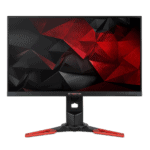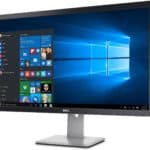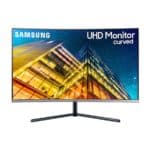Best 32 Inch 4K Monitor
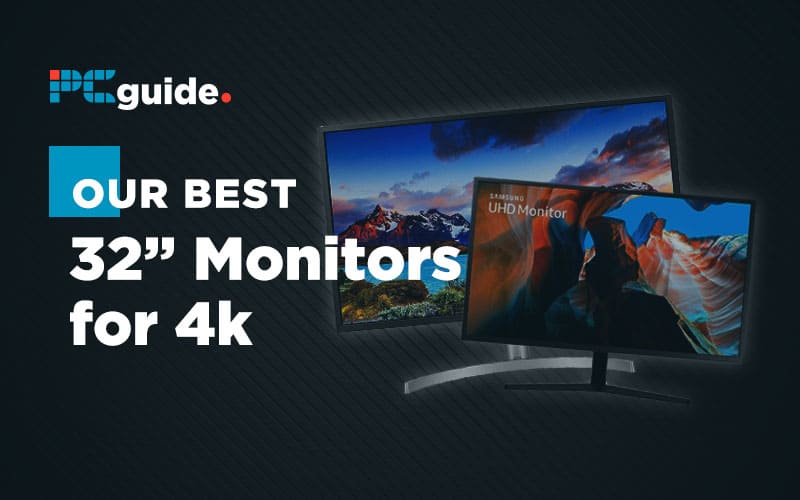
With 1080p resolutions slowly becoming previous generation’s tech, the 4k UHD replacement offers far greater image quality, colors, and sharpness. Due to this, 4k monitors have become more and more mainstream, not costing as much as you may think. In this article, we’re focusing on the 32-inch variant, which might be a little larger than the usual go-to 24 or 27-inch selections, but can be far greater for those utilizing them for office work, creative projects, or even gaming.
Products at a Glance
Best 32 Inch 4K Monitor
- VESA DisplayHDR 600
- 600 Nits Rated
- 3000:1 Contrast Ratio
- Only 60Hz Refresh Rate
LG has been making top-quality monitors for some time now but it’s their 4k range that has really shined. The LG 32UL750-W is one 4k monitor in particular that offers up high-end specs at a very respectable price. Of course, you’ll be getting that crispy 3840 x 2160 UHD resolution but the introduction of VESA DisplayHDR 600 is what provides a much more lifelike image. Additionally, the high dynamic range allows for bolder contrast between the brightest and darkest areas, making for a clearer and more luminous picture. Speaking of luminosity, the LG 32UL750-W has been 600 nits rated, brighter than a number of alternative displays out there. Delving further into the specs, we can see a contrast ratio of 3000:1, a refresh rate of 60Hz, and a response time of 4ms. These combined make for a fantastic all-round monitor catering to whatever you throw at it. However, some of you gamers out there looking at the 60Hz refresh rate may be left feeling a little deflated but as this is a more ‘does all’ display, the 144 or 240Hz rates are reserved for smaller, specialized gaming screens. It does, on the other hand, utilize AMD’s FreeSync technology reducing tearing and stuttering in graphically demanding games, as well as a custom gaming environment consisting of dynamic action sync and black stabilization.
All in all, considering the price of this 32” 4k monitor, it details a fantastic set of specs and an impressive image quality. We 100% recommend this 4k monitor for those looking to multi-task, potentially using it for internet browsing, watching some 4k video, office work, and some casual gaming.
- Nvidia G-Sync Technology
- 4ms Response Time
- Flicker-less Technology
- Only 60Hz refresh rate
A 32” monitor for 4k gaming provides the larger viewport necessary for today’s AAA titles and one that smaller monitors just can’t compete with. Couple this with wide viewing angles and you’ll have potentially one of the most immersive experiences you can get. The Acer Predator XB321HK offers up both of those aspects and more.
Jumping straight into the refresh rate, we can see that it is only 60Hz. Again, like the LG option previously detailed, is lower than the ideal 144Hz but at this screen size, you’re going to be hard pushed to find a monitor that supports this. However, looking at the other specs of this 4k gaming monitor, you’ll most likely be impressed. You’ll be getting Nvidia’s G-Sync technology, making for silky smooth gaming, even in the fastest of twitch shooters, coupled with a 4ms response time to match your lightning-quick reactions. The IPS nature of the display allows for the colors to stay true no matter what angle you’ll be viewing it at and speaking of colors, this thing supports up to 16.7 million of them. Additionally, Acer has included its Flicker-less technology, reducing eye strain when viewing the monitor for long periods. Overall, Acer has created the best 32” monitor for 4k gaming here, including the technology that the smaller displays have, as well as a color-rich IPS display that really makes those gaming hues pop. While the refresh rate is a little lacking, those impressive aforementioned features more than makeup for it.
- Premier Color Technology
- Better than most refresh rate
- Eco-Friendly
- Expensive
For those looking for a truly professional 32” 4k monitor, Dell has created a brilliant piece of kit that will satisfy your needs whether you’re a creative designer, video editor, or even a photographer. The premium, PVC-free materials that the UltraSharp UP3216Q is made from make it durable and long-lasting, allowing you to chop and change your setup, not having to worry about bumps and nicks it’ll take. It’s eco-friendly too with an arsenic-free glass and mercury-free LED panel coupled with a frame made from 25% post-recycled plastic.
While the screen is of stellar quality, the colors and clarity are where this thing truly sets it apart from the others in this price range. You’ll be feasting your eyes on Dell’s Premier Color technology detailing 99.5% Adobe RGB, 100% sRGB, 100% REC709, and 87% DCI-P3 coverage, perfect for minute details in your photography and graphics, taking your work to that next level. You can also expect a color depth of 1.07 billion, keeping sharp details in the blackest blacks and whitest whites.
Coming back to the more basic specs, we can see a 6ms response time, 75Hz refresh rate, and an image contrast ratio of 1000:1 all coming together with the previously mentioned color tech to create a best in class 32” 4k monitor for professionals. So, all in all, if you’re a creative professional that is either using the Adobe Suite for work or if you just like exercising your skills at home, this is the 4k monitor for you. The colors are the best in the game and the overall build quality is one to be admired.
- Fantastic Value
- Freesync Technology
- Seamless Upscaling
- Lesser Build Quality
A budget 4k monitor is something that would be unheard of just a year ago, but as this UHD resolution has become more mainstream, there are some surprisingly high-quality displays at really affordable prices. One of these said displays is the Samsung LU32J592UQUXEN. You’ll be getting a sub-$400 32” 4k monitor that really should cost more. With 8.3 million pixels supporting a wide range of colors and offering incredible clarity, it’s useful for the everyday office work while also being a great choice for professional use. Additionally, it offers a more than impressive widescreen gaming experience boosting contrast when in its inbuilt Game Mode. Like the LG 32UL750-W you’ll also benefit from AMD’s Freesync technology for smooth, minimal screen tearing gameplay. Seamless upscaling is also a welcomed feature, allowing lower resolution images and video to be scaled upwards toward that 4k resolution, making for a crispier overall picture.
Overall, for a budget choice, this is a 4k monitor that says anything but budget. The image quality is almost up there with the LG and you will still get some of the tech that goes into our best overall pick. Additionally, with the nice addition of seamless upscaling, it’s a great choice for those dipping their toe into the 4k world while still operating on some older hardware.
Things to consider
Freesync Vs G-Sync
This whole Freesync, G-Sync terminology is a bit confusing at first but what it boils down to is AMD and Nvidia yet again battling it out to win consumers over. Granted, Nvidia was first to roll out its G-Sync tech, grabbing partnerships with the likes of Acer and ASUS but when it burst onto the scene it did come with one big flaw; compatibility.
G-Sync monitors require a proprietary Nvidia G-Sync scaler module in order to function, which means all G-Sync monitors have similar on-screen menus and options. This therefore increases the price. Freesync steers away from this problem as manufacturers choose whichever scalers they want. More on that to follow.
FreeSync, which is an AMD technology, uses the Adaptive-Sync standard built into the 1.2a DisplayPort. Because it’s part of the DisplayPort standard, any monitor with a DisplayPort 1.2a (or above) input is more than likely compatible. That’s not to say that it’s a free upgrade; specific scaler hardware is required for FreeSync to work, but the fact that there are multiple third-party scaler manufacturers signed up to make FreeSync compatible hardware (Realtek, Novatek and MStar) should mean that pricing is competitive due to the competition.
One clear difference between Nvidia G-Sync and AMD FreeSync is how they handle graphics cards that produce higher frame rates than a monitor can handle. G-Sync locks frame rates to the upper limit of the monitor while FreeSync (with in-game Vsync turned off) will allow the graphics card to produce a higher frame rate. This introduces tearing, but also means that input lag is at an absolute minimum, which is important for twitch gamers such as those who play FPS titles.
Refresh Rate
Changing your refresh rate was more important on older CRT monitors, where a low refresh rate would actually result in the display visibly flickering as it updated. A higher refresh rate eliminated the visual flickering.
On a modern flat-panel LCD monitor, you won’t see any flickering with a lower refresh rate. However, a higher refresh rate results in a much smoother picture. That’s why expensive monitors designed for gaming advertise high refresh rates like 144 Hz or 240 Hz, which is a big step up from the typical PC display’s 60 Hz refresh rate. To us, the difference is noticeable even when moving our mouse around on the screen.
The maximum refresh rate you can use depends on your monitor. In general, cheaper monitors support lower refresh rates than more expensive monitors. If you have multiple monitors connected to your PC, each has its own separate refresh rate setting.
When shopping around for a monitor, a higher refresh rate is usually better, but it isn’t always the most important thing to look for. There are other important considerations like response time, color accuracy, and the monitor’s viewing angle. But you always want to use the highest refresh rate your monitor supports.
In general, modern PCs should automatically select the best, highest refresh rate for each monitor you connect. But this doesn’t always happen automatically, so you may sometimes need to change the refresh rate manually.
Response Time
Response time is closely related to refresh rate in a lot of ways and is the second most important aspect that many gamers will want to keep in mind. Response time is a measurement, in milliseconds, of how long it takes for each pixel to change from one state to the next, usually white to black or grey to grey.
This is important as some VERY cheap monitors will have response times so high that the pixels can’t completely change from one color to the next before the next frame is ready. This results in a streaky and blurry look. However, this only happens if you have response times over 17ms, which none of the monitors on our list– or any of our lists– come even remotely close to.
At lower response times you can actually give yourself a slight competitive edge. For example, a monitor with a 10ms response time will show an enemy emerging from a doorway a brief moment later than a monitor with a 2ms response time. This is actually significant since the average human response time is about 17ms. Shaving even just a few milliseconds off the time it takes for each frame to appear on your monitor can give you a quantifiable advantage in close situations.
Color Gamut
Finally, let’s talk about color gamut. This is actually a fairly complex matter and it involves a lot of color science, but in short, color gamut is a standardized range of colors that are established by leaders in design and video editing, such as Adobe.
Many of the monitors on this list aren’t color calibrated at all meaning they have no specific color gamut, but the Dell monitor covers over 100% of the Adobe sRGB color gamut which is used by most graphic design and video editing professionals. This ensures that how something looks on your screen while you work on it is an accurate and true representation of the colors of that image or video.
This is very similar to how reference style headphones work and ensures consistent quality across various work stations and end-user systems. This is very important to keep in mind and look for if you do any kind of photo or video editing either for a living or as a hobby.
Our Verdict
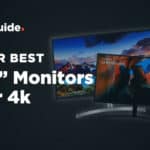
Best 32 Inch 4K Monitor
We have some really quality selections here when looking at the best 32” monitors for 4k. If you want a great all-rounder the LG 32UL750-W is most certainly the way to go. The build quality is fantastic, it looks great, and has some nice technology to improve your viewing experience. It is, however, lacking in that refresh rate category so if you want that perfect gaming experience, the Acer Predator is the route to go down. The budget Samsung option is also impressive considering the cost and makes our list because of that reason. While the Dell UltraSharp UP3216Q is the priciest 32” 4k monitor here, we haven’t reached the absolute limit on cost. If you were looking for an increase in size, dropping a few thousand dollars in the process, the OMEN X Emperium 64.5″ 4K Gaming Monitor is the best of the best, giving you everything and more than you ever could ask for.



